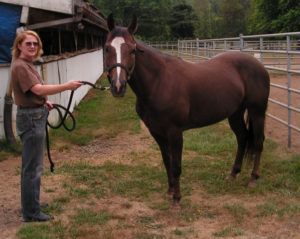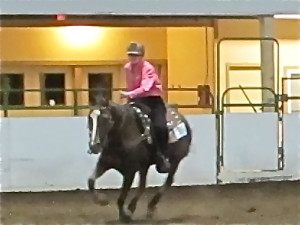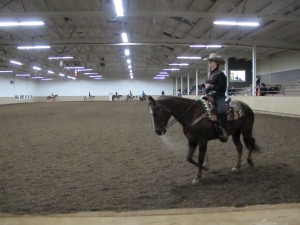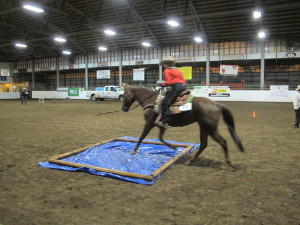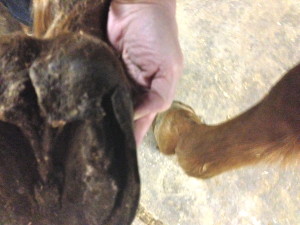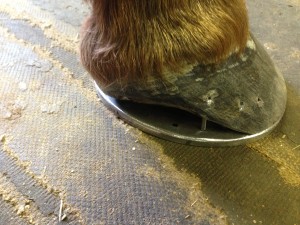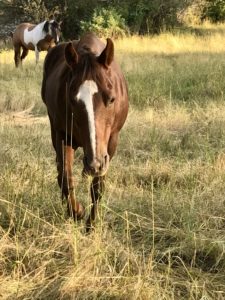Fifteen years ago, the American Quarter Horse Association registered the transfer of ownership of one five-year-old chestnut mare, Miss Olena Chic, from Gregg Shrake to me. I was preparing to start my second year of teaching, and my spouse had suggested that maybe it was time for me to become a horse owner again, instead of continuing to be a lesson rider and dealing with the frustrations of juggling special education teaching with the riding lessons that kept me sane. I’d been riding with Gregg for eight years by this point, and had learned just how one goes about finding a good horse that had a decent temperament and wasn’t a dangerous and poorly trained puke–i.e., enlist a trainer you trust. I showed Gregg several local prospects I’d found on Dreamhorse. Gregg waved them away.
“How about Mocha?” he suggested.
I boggled. I’d known Mocha from a baby. In utero, no less. She was the daughter of Gregg’s prized reining mare, Annie (Miss Lorena Wood) and a young stallion, Chocolate Chic Olena, who had been in training with Darren Stancik, a friend of Gregg’s. Mocha was intended to be Gregg’s personal horse, but he’d been having some health issues. I knew she was for sale. I’d handled her, brought her in from turnout, and even said to her at one point once I knew she was for sale about a year earlier, “I wonder whose horse you’re supposed to be?”
“Um, well…how much?” I asked. Honestly, I expected the price tag to be out of my budget.
Gregg named a figure within my budget. “Want to try her tomorrow?”
“Sure.”
That night I hit the internet, pricing out five-year-old daughters of Chocolate Chic Olena. First of all, I found there weren’t many for sale. Second, I saw a lot higher price tags. But they were in Texas, and a couple were in foal. All the same, this was an opportunity for me to buy a nicely bred mare with a decent temperament.
The trial ride the next day confirmed the deal. I knew Mocha’s half-siblings, by Jac Daniels Neat. I’d lusted after Mocha’s older sister, a dun named Miss Neat Amerika (Erika, after a granddaughter). I’d ridden Mocha’s brother, Tyler. He and I didn’t click because he was the sort of gelding who occasionally needed a clue-by-four applied. Pushy and opinionated, and occasionally bucked. After the Sparkle mare of my youth, I didn’t worry about the possibility of being able to sit any buck, and Tyler’s bucking was nothing like Sparkle’s. But. There had been a day when I watched Tyler in turnout. He’d just come back from reining training. On his own, he went out about 30 feet from the barn wall, ran as hard as he could toward it, then stopped hard. Paused, then jogged back to his starting place and did it all over again. I think I watched him do this for about five minutes.
(What Tyler was doing was copying a reining training technique known as “fencing,” where the trainer uses a fence as visual reinforcement of the whoa cue to get a good, hard stop. He clearly enjoyed it. Over the years, I’ve seen Mocha do the same thing, although her preference is to run hard at the fence, stop hard, then roll back over her haunches and gallop off. When she was turned out to run in Gregg’s arena, she’d gallop around to get up a head of steam, then run on the diagonal as hard as she could to a corner, stop at the last minute, then roll back, sending dirt flying. Tyler loved the hard stop. Mocha loves the rollback.)
But when I got up on Mocha, I could tell the difference between her and Tyler. The first time I breathed a soft “whoa” and Mocha stopped, I was sold. I felt the difference between her stop and Tyler’s stop. Not that I had any money to go show a horse like Mocha, but the ability to own and ride a horse like her? It was everything I’d dreamed about in the eight years that I’d been a lesson rider both at Shrake’s and at Lake Oswego Hunt.
And so the saga began. Mocha was opinionated, like her mother and siblings. Training had its interesting moments. Not because she was mean, or a bucker. But Mocha had firm opinions about what patterns should be. She needed schooling under saddle to soften up a rough trot and canter. She needed to learn flying changes. She had the foundation to be a reiner, but needed more training.
Gregg and I spent the next few years putting that foundation on her. I didn’t have the time or money to show, much less travel to where I could find a reining competition in that era. Nonetheless, in lessons I learned how to make a reiner.
Eventually we showed in a few reining classes.
By the time of this picture, I’d learned not to wear my Western hat in reining competition. The first time we took off in a large fast circle, even though the tan felt was jammed down hard on my head, the brim was flapping as Mocha galloped harder than she ever had in her home arena. I flicked it off as we passed the gate, for ease in picking it up later. Gregg told me that when I did that, he knew I was going for it. We didn’t do all that well due to pilot error–I had problems remembering just how many spins we had done. But there was no question in my mind that Mocha liked those reining classes…along with trail classes as well.
We did show in other classes, but I learned quickly that unless it was a trail class, we were unlikely to place high. Oh, it happened, but it was not common. Classes on the rail favor a slower-moving horse. That’s not Mocha. But she enjoyed the puzzles that trail class presented, and her mental discipline meant that she could easily make the quick transitions of gaits that are part of an arena trail class. We got good enough at it that we ended up finishing second to a professional in a complicated timed trail class, and beat pros. All the same, Mocha was a real pleasure to show. At her first show (a huge one at Mt. Hood Equestrian Center), I parked her where she could watch the other horses. She found it interesting. I worked at making shows feel like fun to her, and she took to the show life–not that we did a lot of showing.
But things happen. One cold January day I showed up at the barn after work to find Mocha lame in her left fore and right hind. Gregg had to take her by the tail to help me guide her out of her stall. She was going to turn fourteen in March, and hubby and I were in the process of buying a retirement home in Wallowa County. I planned to take Mocha there. But what I saw that night left me in tears. I’d had her left unshod for four years. When I picked up her left fore, I saw a huge hole between the sole and the hoof wall.
White line disease. Never did figure out what was wrong with that right hind. She’d already been getting hock injections to ease the pain of joint fusion. But that damned white line disease. Kenny, her farrier at the time, was grim.
“This killed her mother,” he said flatly, before resecting her hoof, putting on a bar shoe, and issuing strict instructions to me about her care. Mocha was stallbound. She was not to leave that stall unless she was attached to a human. She could be ridden at a walk, bareback. No saddle. No excess weight.
That regime went on for six months. And after that, it was like playing whack-a-mole with that damned white line disease. I’d think we’d have it beat, then bam! Back it came again.
And then we moved her to Wallowa County and a drastic life change. From life in the barn she’d been in since birth, she went to living outdoors in a pen. Not just around other horses, including a breeding stallion, but PIGS. That first summer was rough and hard. Mocha lost weight to a scary degree. She was clearly in pain of some sort. She colicked. She developed monster abscesses in both forefeet–which led to x-rays, and the discovery that shoeing her according to her exterior angles (which is common) was not correct for her. She’d lost the tip of the coffin bone in both forefeet, and in her current shoeing angles, that tip was pointed straight down at the ground.
Fortunately, we had access to a good corrective farrier. It took a year, but the angle issue got fixed and in the drier climate of Wallowa County, the white line disease went away. All the same, to keep her sound and pain-free, she has to live in front shoes year-round.
But things got better. Mocha learned to be a road horse and a trail horse–both of which she enjoys. As she regained weight, I realized that she had indeed been underweight for some time, most likely due to the pain. She took to the life of a 24/7 pasture horse, objecting to being stalled (one time when the ranch owner called to suggest we stall her because she was slipping and sliding on the ice, she had other ideas. At Gregg’s, she’d stay politely in her stall even with the door open. Not so at the ranch. While hubby got hay, I got her grain. We left the gate unlatched. She pushed it open and was on her way back to the field. Did I say she had opinions? Oh yeah, she has Opinions).
Now she is twenty years old. She’s in good weight. She still has her quirks–one winter she adopted a yearling elk as her baby (when the ranch owner sent me the video, because it happened when we were doing business in Portland, I groaned because I knew it would be a problem. It was). When the cows are in the pasture with the herd, she’s one of the horses who will occasionally round them up (I heard that the first time the cows were in the field, Mocha rounded them up, then took them down the fence in fine reined cowhorse mode). We’ve had fifteen good years together, and I spoil the heck out of her in hopes that we’ll have many more.
Happy fifteenth Gotcha Day, Miss Olena Chic. Best damned horse I’ve ever owned.

